Your brand personality shapes how customers feel about your business. It turns boring companies into beloved brands that people choose with their hearts, not just their wallets. This guide shows you how to build, measure, and improve your brand personality for real results.
What Is a Brand Personality?
Brand personality is the set of characteristics and attributes associated with a brand. It can create an emotional connection between the user and the brand, which helps shape the user’s perception of the company. Brand personality traits are critical to brand positioning.
A well-designed brand logo that reflects the brand's colors, fonts, and personality is crucial in establishing a strong visual identity and maintaining a consistent brand personality.
What's Included in Brand Personality by Clay

A well-known, unique brand personality makes a business unique and recognizable to its target market. A brand persona is identifying a brand to customers and building and developing relationships with them. It helps grow brand loyalty and equity.
The persona explains why Starbucks customers feel comfortable in their cafes and why BMW clients cannot drive anything else. An efficient and clearly defined brand identity.
The visual aspects of UX design, such as color palette and font selection, can communicate brand personality in a subtle yet powerful manner.
Why Brand Personality Matters
A strong brand personality isn’t just a marketing buzzword — it drives bottom-line results.
Key Brand Personality Stats to Know by Clay

Here’s a closer look at how a well-defined brand personality helps your business:
Makes You Stand Out
A distinct personality is the best way to be memorable in a sea of look-alike competitors. It will get you noticed and chosen.
Builds Emotional Connections
Customers prefer brands that feel like a great friend. Personality makes that connection happen, turning a simple transaction into a relationship.
Creates Customer Loyalty
When people love your brand for who it is, they’ll overlook lower prices elsewhere and stick with you.
Allows Premium Pricing
A strong, appealing personality makes customers willing to pay more because they perceive added value in being part of your brand community.
Builds Trust
Customers feel they can count on you when your personality is clear and consistent. Trust is hard to earn and easy to lose, so make sure your personality shows up the same way every time.
Benefits of a Strong Brand Personality by Clay

Developing Your Brand Personality Strategy
A strong brand personality starts with research and a brilliant plan. Before picking personality traits, you must know your market, customers, and competition. This process enables personality assessment and supports personality assessment by laying a solid foundation for decision-making.
Research Your Market
Study Your Customers: Gather insights using surveys, interviews, and real-world observations. Track age, values, hobbies, and daily choices. Build customer personas that include personality traits they admire. This step maps personality archetypes based on the real motivations and behaviors of your audience.
Analyze Competitors: Create a personality map of rival brands. Spot traits they do not claim. These gaps allow you to stand out and attract customers who want that missing vibe. This also links to personality archetypes that your competitors might not represent — helping you differentiate.
Watch Cultural Trends: The traits people admire can change. Monitor social shifts, new words, viral memes, and changing values. Understanding these trends will help you know what personality traits your audience may soon value or reject and how your brand aligns with personality archetypes that feel current and authentic.
Choose Your Personality Traits
Limit your set to three to five dominant traits. This keeps your brand identity clear. You can include two or three secondary traits to add flavor. Every trait must tie back to your company values and mission.
Primary Traits: These traits are your brand’s “core DNA.” Make sure they appear on your website, in ads, in customer service scripts, and in product packaging, without exception.
Secondary Traits: These traits add personality layers. A brand that is officially “friendly” may also be “playful” or “curious” in small ways. This makes your brand feel more human and relatable.
Situational Flexibility: Outline moments when a trait can shift slightly. You may be more formal with investors but joke with teenagers on social platforms. Plan these shifts so you stay on-brand even when the context changes.
Your traits must feel fundamental to your company’s culture. A fake vibe is obvious and can break customer trust in seconds.
Why You Need a Consistent Brand Personality by Clay

Position Your Brand Through Personality
- Let Your Brand Personality Claim Your Market Spot: Use your brand’s personality to grab a unique space in the market. Show customers why your brand is the one they want.
- Link Personality Traits to Value: Connect personality traits to what you actually offer. If your product is top-of-the-line, give your brand a sophisticated or super-skilled vibe. If you solve challenging problems, lean into innovative, dependable, or resourceful traits.
- Support Your Pricing with the Right Personality: Make sure your personality fits your pricing. A premium personality can help you charge more and still win. Meanwhile, a friendly or down-to-earth vibe can attract budget-conscious folks.
The Psychology of Brand Personalities
The Brand Archetypes: Connecting Psychology and Brand
Recognized psychologist Carl Jung proposed that humans employ symbolism to comprehend complex ideas more easily.
Carl Jung theorized that certain established paths to a deeper level of understanding could be classified according to personality traits, making it easier for customers and companies alike to recognize the customer avatar they seek. He referred to these classifications as ‘archetypes’.
Establishing precise brand archetypes will mirror your brand's essence and help match brand personality types with individual Customer Personas accurately. This approach is widely accepted for any branding strategy, making it an ideal way for managers to sharpen their team’s objective.
By recognizing these archetypes, brand managers can capitalize on their effectiveness and direct actions accordingly. Aligning brand archetypes with the brand's personality traits helps create a cohesive and recognizable brand identity.
With twelve distinct brand archetypes to choose from, the possibilities are endless. You can become an Innocent, Everyman, Hero, Outlaw, Explorer, Creator, and Ruler, or delve further into Magician territory. Alternatively, you may opt for a Lover persona and Caregiver-like traits - don’t forget about Jester or Sage!
Brand Archetype Examples by Clay

To provide some perspective, here are a few examples of common brand archetypes:
- The Innocent radiates joy, optimism, and faith; brands like Coca-Cola, Nintendo Wii, and Dove often embody this persona.
- The Everyman strives to connect with others. Expect traits such as supportiveness and affability from IKEA, Home Depot, or eBay.
- The Hero who is daring and determined to make positive societal changes - think Nike's 'Just Do It' campaign or BMW's bold advertisements.
- For the rule-breaker, The Rebel looks to push boundaries and challenge norms. Think of brands like Virgin, Harley-Davidson, and Diesel.
- For those seeking exploration and excitement, meet the Explorer, who finds motivation in travel, risk-taking, and fresh experiences such as Jeep or Red Bull.
- Meanwhile, for those who seek invention through building something special and of long-lasting importance, enter the Creator with iconic brands Lego, Crayola, or Adobe!
- The Ruler: bringing structure and sanity to the world, Rulers are often seen as authoritative yet responsible. Think of Mercedes-Benz, Microsoft, or British Airways.
- The Magician: with a mission to make dreams come true, Magicians have an air of spirituality about them—Apple, Disney, and Absolut could be fine examples.
- The Lover awakens intimate emotions and motivates love, ardor, romance, and dedication. Brands such as Victoria's Secret, Chanel, and Haagen Dazs exemplify this archetype.
- The Caregiver safeguards others with tenderness and kindness while being compassionate, nourishing, and beneficent. Johnson & Johnson, Campbell’s Soup, and UNICEF are good examples of this type of brand character.
- The Jester: brings joy to the world using hilarity. Playfully having fun but sometimes even mischievously! Old Spice, Ben & Jerry’s, or M&Ms provide us with perfect instances for this category of personality branding archetypes.
- The Sage: The Sage is devoted to aiding the world in uncovering greater knowledge and wisdom. As insightful advisors or mentors, brands such as Google, PBS, and Philips represent this archetype.
The Brand Personality Framework
Has anyone felt an affinity for certain brands? Social psychologist Jennifer Aaker says we can measure branding personality in five dimensions: sincerity, excitement, competence, sophistication, and ruggedness.
Let’s take a more detailed look at these brand personality dimensions:
- Sincerity: genuine, genuine, pure-hearted, joyful
- Excitement: adventurous, vibrant, creative, modern
- Competence: trustworthy, smart, accomplished
- Sophistication: high-class, delightful
- Ruggedness: outdoorsy, resilient
Brand Personality Framework by Clay

Sophisticated brands, which are associated with luxury, elegance, and high-quality products, often embody the dimension of sophistication.
Each of these dimensions consists of several types of facets:
- Down-to-earth: grounded, family-oriented, small-town
- Honest: genuine, sincere, authentic
- Wholesome: pure, genuine
- Cheerful: joyful, warm, friendly
- Daring: adventurous, trendy, thrilling
- Spirited: lively, hip, youthful
- Imaginative: creative, one-of-a-kind
- Up-to-date: modern, independent, contemporary
- Reliable: dependable, diligent, secure
- Intelligent: smart, technical, corporate
- Successful: accomplished, leader, confident
- Upper class: affluent, glamorous, attractive
- Charming: alluring, feminine, suave
- Outdoorsy: nature-loving, masculine, western
- Tough: resilient, rugged
Constructing a brand's personality traits requires careful consideration and measurement of various facets, with each trait being assigned a value between one and five. One represents the least alignment to the brand, and five fully adhere to its values.
Once you have determined your brand's qualities, you must instill those values into everything from the words you write on your social media channels and newsletters to what you say in press conferences or when communicating with customers. How well a company displays its branding also plays an integral role. It may include customer loyalty programs, logos, typography, product design, and visuals. All of these elements combined create an effective representation of your organization that can be seen at every touchpoint.
How to Express Your Brand Personality
Effectively expressing your brand personality requires strategic and thoughtful implementation across various channels. Here are several ways to convey your brand personality:
Define Your Brand Voice and Tone
Your brand voice and tone should consistently reflect your brand’s personality and values. Whether your brand is playful, serious, professional, or casual, the language and style you use in your communications should be consistent, whether on social media, email newsletters, or customer service interactions. Defining your brand voice helps ensure everyone on your team communicates cohesively.
Visual Identity
Your logo, color palette, typography, and imagery are crucial in expressing your brand personality. Visual elements should align with the traits you want your brand to be associated with. For example, vibrant colors and dynamic graphics convey energy and excitement, while a minimalist design may reflect sophistication and elegance.
Storytelling
Sharing stories about your brand’s origin, mission, and values can create an emotional connection with your audience. Authentic storytelling that resonates with your target demographic can make your brand more relatable and memorable. Highlighting customer stories or behind-the-scenes content can also humanize your brand and reinforce its personality.
Storyteling Types of Content by Clay

Customer Engagement
Engaging with customers in a manner that reflects your brand personality is key. This includes how you respond to inquiries and feedback, your interactions on social media, and the overall customer experience you provide. Personalized and thoughtful engagement can strengthen the emotional bond between your brand and its customers.
Content Creation
Create content that embodies your brand personality. The content should consistently reflect your brand's attributes and values, whether it’s blogs, videos, podcasts, or social media posts. Educational and entertainment content that aligns with your brand’s personality can help attract and retain an engaged audience.
Agencies like Clay, Instrument, and Basic/DEPT® are the best at integrating brand personality into digital product design — from layout and motion to tone and interaction. Their designs look beautiful and feel true to the brand’s voice, turning every click into a brand moment.
Brand Personality Examples
Here are some interesting brand personality examples:
Chobani
Chobani, the Greek yogurt company, has positioned itself as a compassionate and down-to-earth brand focusing on quality and ethical sourcing. Their brand personality revolves around being "genuine" and "wholesome."
Chobani is not just about selling yogurt but also about nurturing the health of its customers and promoting social good. This is reflected in their advertising campaigns, which often focus on real, human connections, such as their "Food Should Do Good" slogan.
What sets Chobani apart is its authentic commitment to its values. They emphasize using natural ingredients and sustainable farming practices, building trust and loyalty with consumers who care about health and ethical consumption.
Source: chobani.com
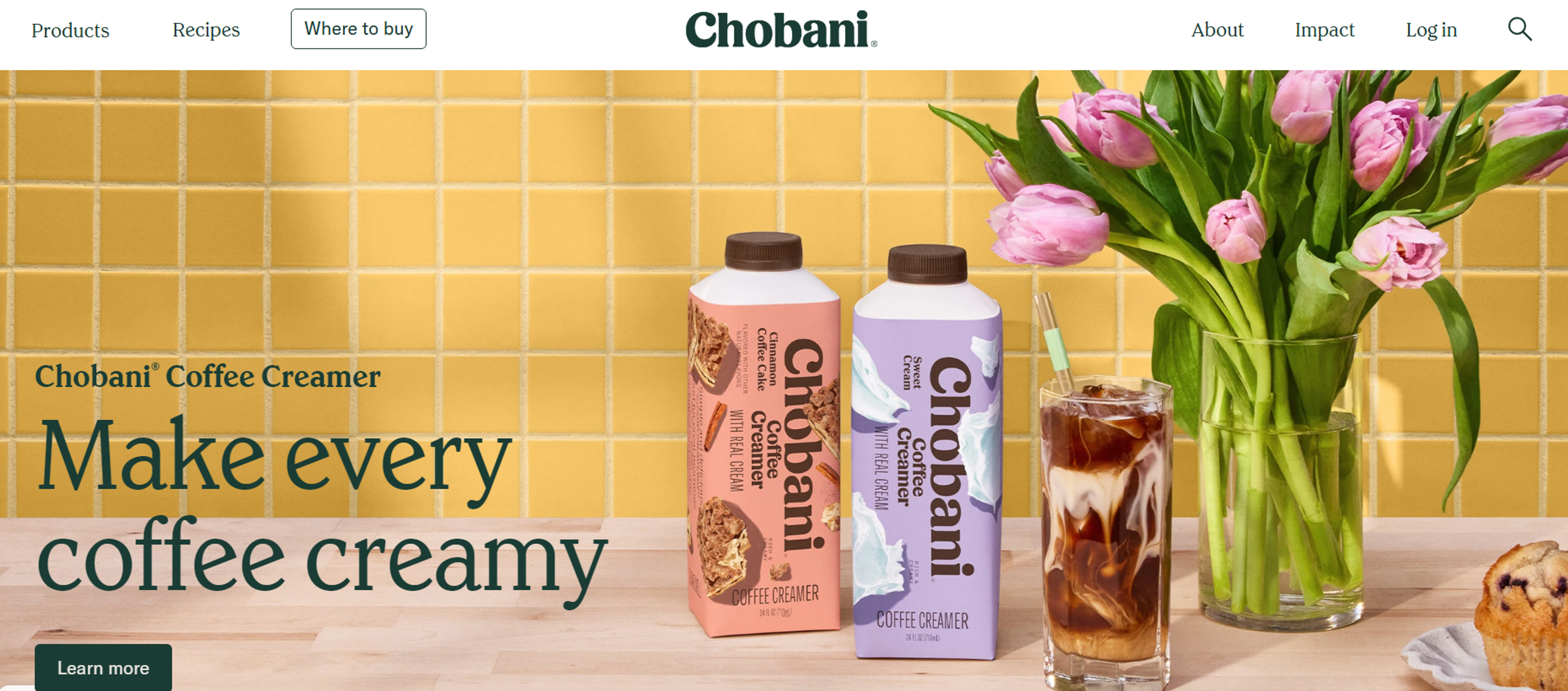
Streetbeat
We characterized Streetbeat’s brand personality by dynamism, innovation, and reliability, reflecting its mission to provide advanced financial insights and tools. This personality is conveyed through bold typography, a rotating logo symbolizing market fluctuations, and vibrant visual elements. By emphasizing these traits, Streetbeat connects with a tech-savvy, financially savvy audience, reinforcing its identity as a forward-thinking and dependable fintech brand.
In the dynamic world of crypto, establishing a unique and compelling brand identity is essential for standing out amidst fierce competition. At Clay, we specialize in creating crypto brands that capture the essence of innovation while instilling trust and transparency - cornerstones of the blockchain industry.
Streetbeat brand personality by Clay
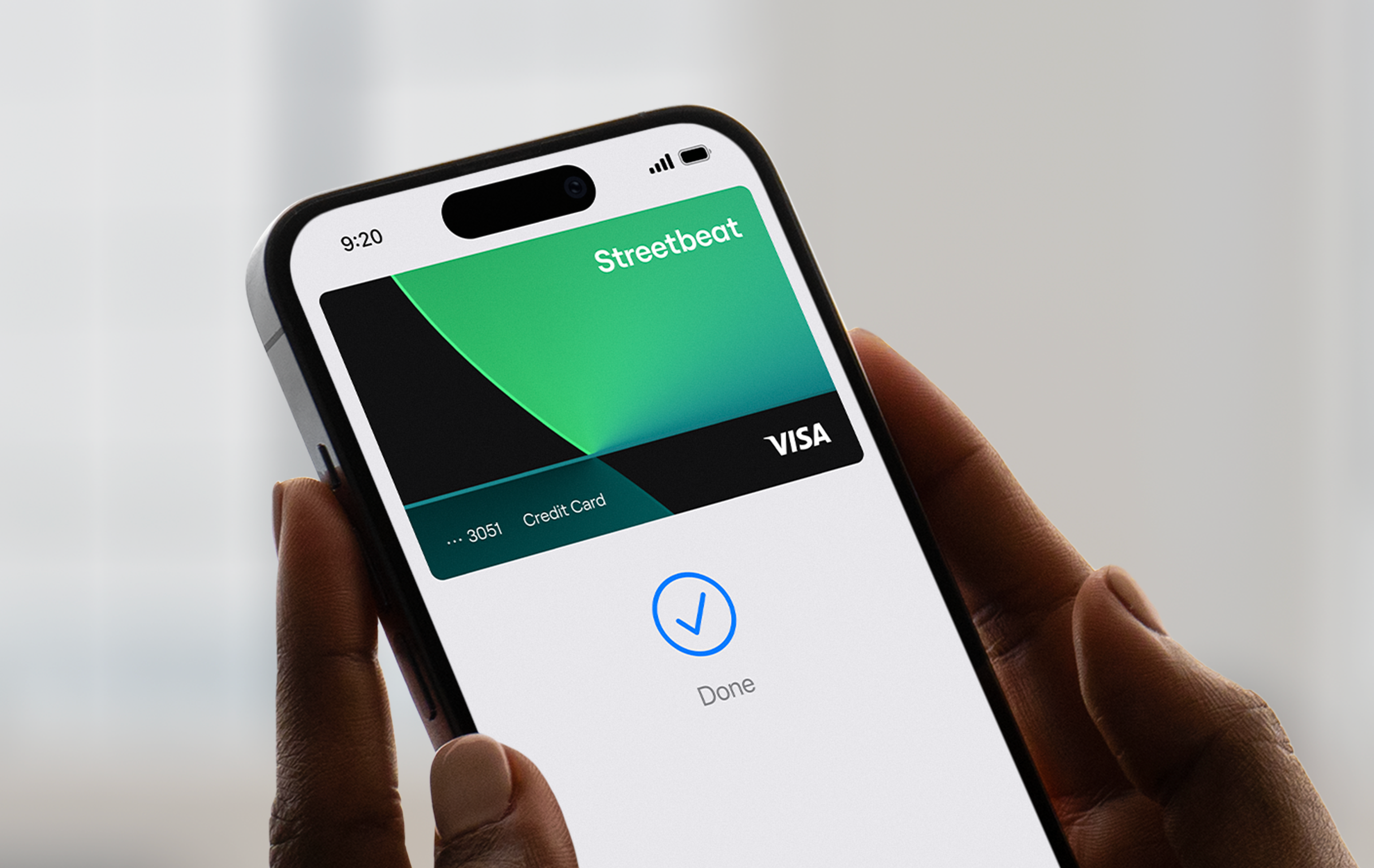
Aesop
Aesop, the luxury skincare brand, has crafted a brand personality that is both refined and artistic. With a minimalist, almost clinical aesthetic and a focus on high-quality ingredients, Aesop exudes sophistication and elegance. Their personality combines "Sophistication" with a touch of "Creator" — emphasizing artistry in their products and branding.
Aesop’s stores are carefully designed, often with unique architecture and thoughtful, artistic details that enhance the experience of purchasing their products. Their communication is minimalistic yet poetic, focusing on quality and craftsmanship. This creates a brand identity that appeals to a more discerning, artistic audience who appreciate the finer things in life.
Source: aesop.com

Since personality traits can be considered human traits, one can try defining brand personality by comparing your company's personality with that of an individual. It enables us to apply psychology in brand promotion.
Developing a Brand’s Personality Strategy: Tips and Key Benefits
When creating a brand personality strategy, there are several steps marketers can take to ensure success. Here are some tips:
1.
Identify Your Target Audience. To create an influential brand personality, it is essential to identify your target audience and understand its preferences and values.2.
Focus on Emotion. To optimize brand loyalty, create an emotional connection with your target audience.3.
Leverage Color Psychology. Use color psychology to create visual elements that support brand personality in UX design and marketing campaigns.4.
Monitor Brand Perception. Pay attention to how customers perceive your brand and make changes if necessary.5.
Establish a Unified Brand Image. Ensure brand consistency across all marketing materials to create a consistent tone and a unified brand image.
Creating an effective brand personality strategy is essential for businesses looking to build strong customer relationships and establish great brand loyalty.
Brand Personality Pyramid by Clay

Incorporating your own brand personality provides several key benefits, including:
- Improved user experience. By creating a layout based on the target audience's needs and brand personality, the company's website or app will likely offer an enjoyable experience for users.
- Increased loyalty and engagement. Customers who connect emotionally to a company's brand are likelier to become loyal customers. This loyalty can help boost the company's bottom line and ensure continued success, which leads to increased engagement and higher conversion rates.
- Improved brand recognition. When users can recognize a company's brand personality, it helps create a memorable experience that leaves an impression. This leads to greater brand recognition and awareness.
Creating a Brand Personality Statement
A brand personality statement is a concise and clear description of the personality that a brand wants to convey to its target audience. It serves as a guide for the brand’s tone and voice, ensuring consistency across all marketing channels and customer interactions.
To develop a personality statement, consider the following steps:
1.
Define your brand’s values and mission: Identify the core values and mission that drive your brand’s purpose and behavior. This foundational step ensures that your brand personality aligns with what your brand stands for and aims to achieve.2.
Identify your target audience: Understand your target audience’s needs, preferences, and pain points to create a personality that resonates with them. Knowing your audience helps tailor your brand’s personality to appeal directly to those you want to attract and retain.3.
Research your competitors: Analyze your competitors’ brand personalities to differentiate your brand and create a unique identity. This competitive analysis helps you identify gaps and opportunities to stand out in the market.4.
Brainstorm adjectives: Use the Aaker Model as a starting point and brainstorm a list of adjectives that describe your brand’s personality traits. Consider how you want your brand to be perceived and what human characteristics best represent your brand’s identity.5.
Narrow down your options: Select the top 3-5 adjectives that best capture your brand’s essence and create a unique personality statement. These adjectives should encapsulate the core of your brand’s personality and guide all your marketing strategies and communications.
Example of a brand personality statement:
“At [Brand Name], we’re a [adjective 1], [adjective 2], and [adjective 3] brand that’s passionate about [brand mission]. We’re committed to [brand values] and strive to make a positive impact on our customers’ lives.”
By following these steps, you can create a brand personality statement that serves as a cornerstone for your brand’s identity, ensuring that your brand communicates consistently and effectively across all touchpoints. This clarity helps build a strong, recognizable, and relatable brand that resonates with your audience and fosters long-term loyalty.
Using Psychology Aspects in the Design of Brand Identity
Color is a powerful tool that can help to create an emotional connection with users. Color psychology can provide insight into how different colors evoke certain emotions and feelings in users. Here are a few tips on using color psychology for maximum impact:
- Choose Colors that Represent Your Brand's Personality. Use colors that fit your brand's core values and help communicate its personality to your target audience.
- Use Color Contrast to Enhance UX Design. Incorporate color contrast in your brand visual identity and design to help guide user attention and create aesthetically pleasing visual elements.
- Consider Color Meaning. Different colors can evoke different reactions from users, so consider the meaning of each color and how it might affect user experience. For instance, blue conveys trustworthiness, while yellow invokes energy and optimism.
- Imagery is another element that should be included in brand personality. Designers can create an emotional bond with users by choosing the right images. For example, photos of people or a particular setting that reflects the brand's values can foster a stronger bond between the user and the company.
- Finally, language should reflect the brand personality to resonate with the user. By using language that aligns with the brand's tone and personality, one can craft a unique experience that engages users meaningfully.
Creating Your Personal Brand Statement by Clay
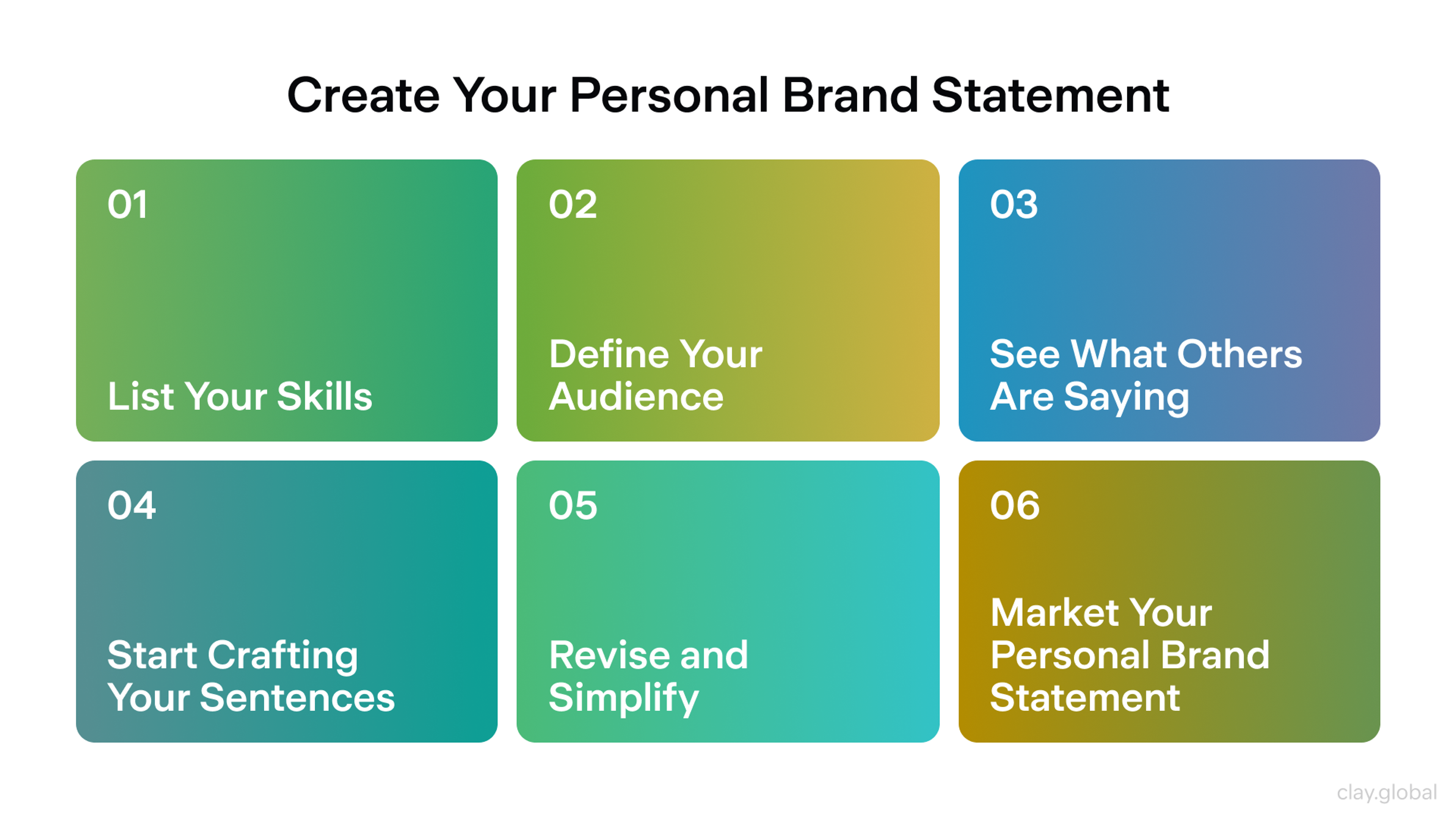
By implementing psychology in brand identity design, marketers can create visual elements that support brand personality and help foster strong relationships between brands and their users.
Measuring and Evolving Brand Personality
To ensure your brand personality remains effective and resonant with your target audience, it's crucial to implement a systematic approach to measurement and evolution. This process involves regular assessment, data collection, and strategic adjustments. Let's explore the key strategies in detail.
Conduct Regular Brand Audits
Brand audits provide a comprehensive overview of your brand's current state and its perception in the market. These audits should be conducted annually or bi-annually, depending on your industry's pace of change. A thorough brand audit evaluates all brand touchpoints, including your website, social media presence, advertising campaigns, product packaging, and customer service interactions.
SWOT Analysis by Clay
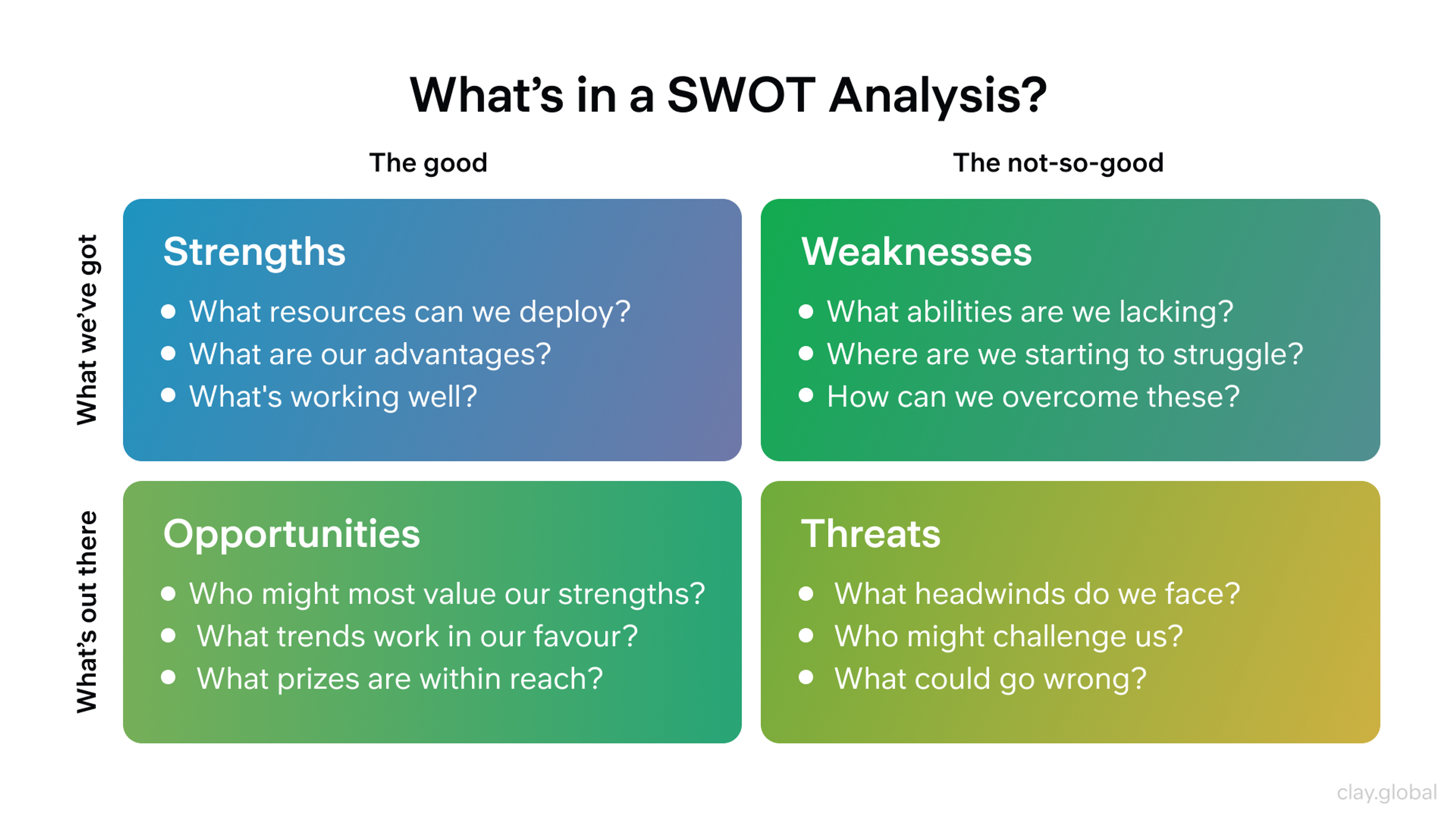
The audit process typically involves several methods. A SWOT analysis (Strengths, Weaknesses, Opportunities, Threats) can offer valuable insights into your brand's position.
Competitor analysis allows you to benchmark your brand personality against industry standards, helping you identify areas for differentiation or improvement. Internal stakeholder interviews are also crucial, as they help gauge alignment between the intended and perceived brand personality within your organization.
Monitor Customer Perception
To keep your brand personality strong, you must know precisely how your customers see it. You can do this in lots of ways. One effective method is to send out quantitative surveys based on Aaker's five-dimensional brand framework. These surveys give you precise numbers that you can track month after month, spotting patterns and sudden changes in how people feel about your brand.
Don't stop there. Use qualitative surveys that feature open-ended questions. This lets customers share their thoughts in their own words, so you get deeper, more colorful feedback about how your brand is connected to their lives. Focus groups can add still more depth. When you bring together small groups of your target audience to discuss your brand, you can dig into the feelings that matter.
Net Promoter Score (NPS) by Clay
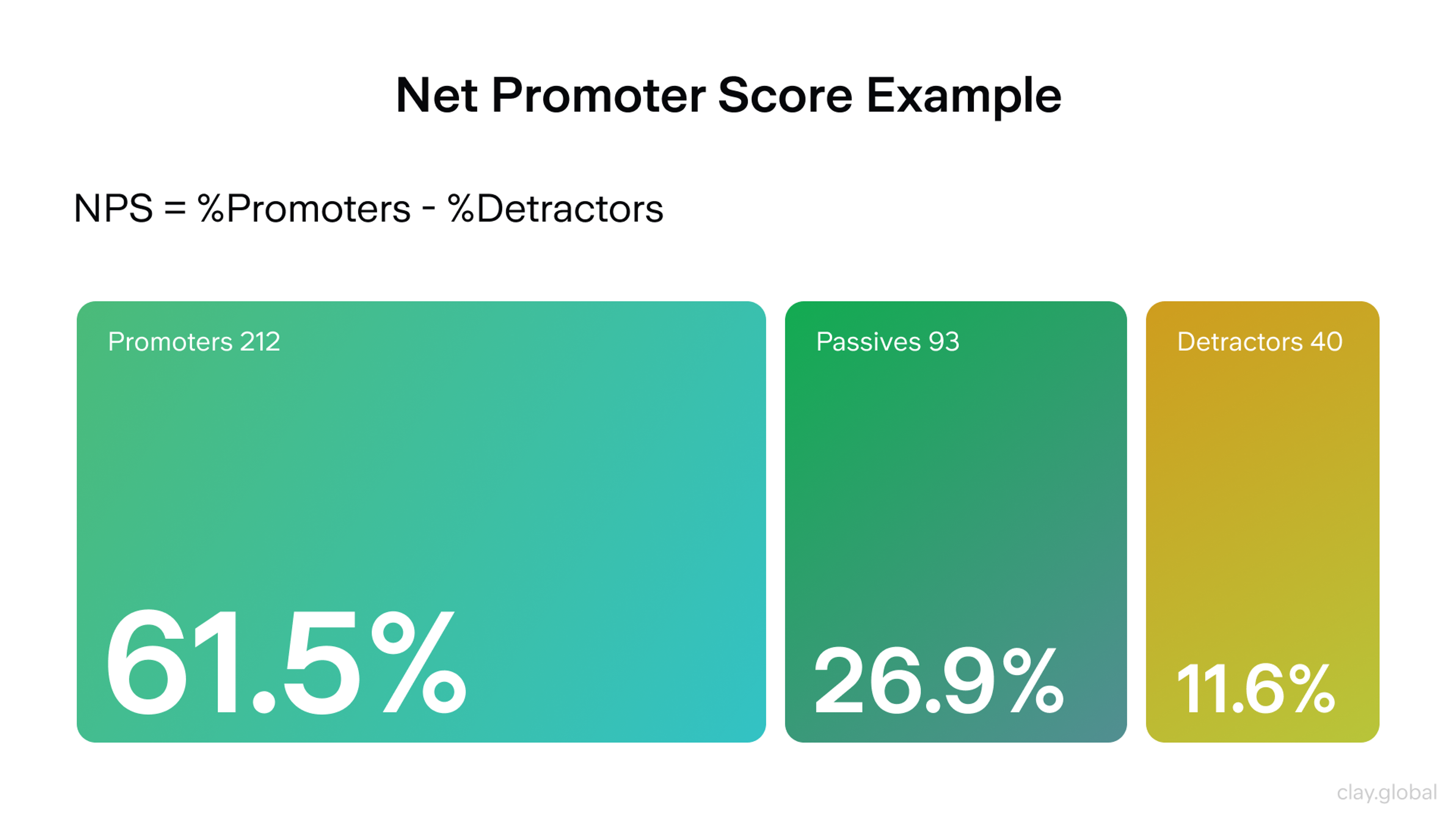
Keeping an eye on your Net Promoter Score (NPS) is another simple yet powerful move. This single number tells you how loyal and happy your customers really are. You can also comb customer service records, online reviews, and testimonials. These everyday conversations show how your brand personality comes through in everyday interactions.
Analyze Social Media Mentions and Engagement
Social media is a live stage where your brand personality gets constant commentary. Use social listening tools like Brandwatch, Sprout Social, or Hootsuite to track brand mentions across platforms 24/7. A good tool will pull in mentions, comments, and shares, showing who's talking, how often, and where.
Most of these platforms also add sentiment analysis. This feature quickly determines whether comments are positive, negative, or neutral. You can see the emotional tone behind a single tweet or a trending hashtag, helping you understand the larger mood around your brand. Dive into this data to adjust your brand voice, calm a brewing storm, or celebrate good vibes.
Stay Attuned to Market Trends and Cultural Shifts
As seasons change, brand personalities must adapt to new markets and cultural climates. Schedule regular brainstorming sessions to review updated industry reports and listen to forecasts. Webinars and in-person conferences on the latest consumer trends are not optional extras — they're invitations to stay current.
Outside industry lanes, your brand personality can drift if you ignore society. Events or cultural movements can shift expectations, like the broader push for sustainability or social justice.
Shock waves can be small or huge, but ignoring them often means losing consumer trust. Watch for gradual or sudden shifts in consumer preferences, values, and behaviors, as they can redesign the lens through which new audiences view your tone and character.
Gradually Introduce New Personality Traits
Once you've pinpointed ways your brand can grow, make those changes step by step. It's essential to keep your brand feeling stable while still moving forward. Add new personality traits or tweak the ones you already have a little at a time — this will keep your audience from getting confused. A smart way to start is to test the new traits on a small group before rolling them out to everyone.
Brand Personality Traits by Clay

Always check that the changes you consider align with your brand's core values and mission. Include internal teams in the picture, too, so everyone knows what's happening and can speak with the same voice wherever customers interact with your brand.
Sometimes the personality update will require a new content strategy. That might mean switching your tone in written posts, refreshing the colors and fonts in your visuals, or choosing different stories to share. Keep the personality in focus, and the content will follow.
FAQ
What Is Brand Personality?
Brand personality is the set of human traits linked to a brand. It shapes how people feel and behave toward you, influencing positioning, preference, and long-term loyalty.
Why Does Brand Personality Matter?
A clear brand personality makes you memorable, builds emotional connection, supports premium pricing, and strengthens trust by staying consistent across every touchpoint.
How Many Traits Should I Choose?
Select 3–5 primary traits and 1–3 secondary traits. Keep them tied to your mission and values, and document where small tone shifts are acceptable.
What Are Brand Archetypes And How Do They Help?
Brand archetypes are recurring character patterns (like Hero, Sage, or Creator) from psychology. Picking one primary and one secondary archetype gives teams a shared compass for decisions and storytelling.
What Is Aaker’s Brand Personality Framework?
Aaker’s framework organizes brand traits into five dimensions: sincerity, excitement, competence, sophistication, and ruggedness. It helps structure surveys and measure brand personality consistently over time.
Read more
Conclusion
Although we may not be able to interact with the brands that shape our lives physically, this doesn't diminish the emotional connection we have formed. Our preferred brands become an integral part of who we are, and their unique traits help define us compared to others.
Building a consistent personality will help your company. Defining a brand personality is an excellent way of creating brand value. However, you must understand your audience before deciding on your chosen brand personality.
Psychology can create an emotional bridge between the user and the brand. Understanding the target users' needs, values, and goals can create an enjoyable, lasting experience.


About Clay
Clay is a UI/UX design & branding agency in San Francisco. We team up with startups and leading brands to create transformative digital experience. Clients: Facebook, Slack, Google, Amazon, Credit Karma, Zenefits, etc.
Learn more

About Clay
Clay is a UI/UX design & branding agency in San Francisco. We team up with startups and leading brands to create transformative digital experience. Clients: Facebook, Slack, Google, Amazon, Credit Karma, Zenefits, etc.
Learn more


